Emigrant Liners and Cargo Ships
Achille Lauro was born on 16th June 1887 as the fifth of six children of shipowner Giaocchino Lauro and Laura Cafiero at Piano di Sorrento in the Sorrento peninsula at the southern end of the Bay of Naples. As a teenager, his father sent him on Transatlantic voyages of his sailing ships in order to remove him from unlikely romantic liaisons with young Neapolitan girls. His father was also a leading shareholder of the steamship company Societa Sorrento Penisola, established in 1902 to compete with the Societa Neapoletana Nave, the governmental concession for postal services with a monopoly of maritime services in the Gulf of Naples. Achille graduated from the Nino Bixio Naval School in Naples in 1906 at a time when his father’s businesses were going through a difficult period, with the Societa Sorrento Penisola having been placed in liquidation in 1905. Achille had also lost two elder brothers and two uncles at sea when their vessels had been sunk.
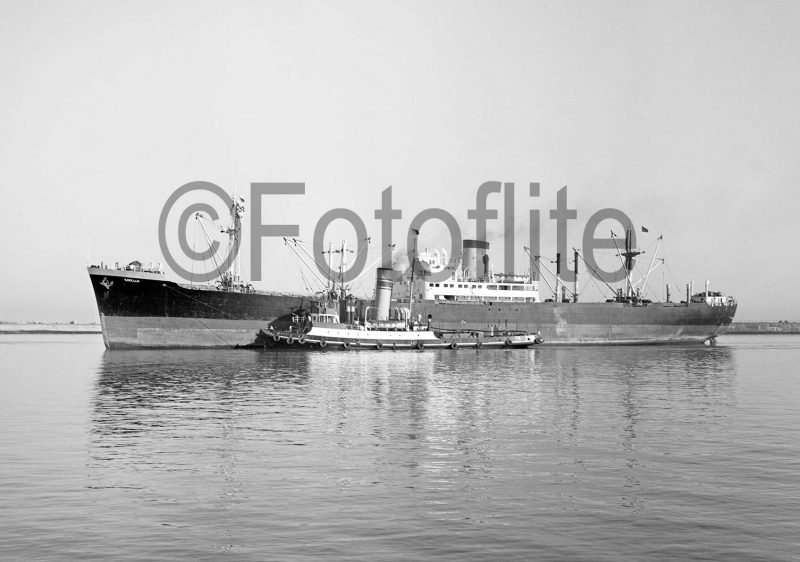
His father died when he was twenty three years of age in 1910, and he inherited a small fleet of three sailing ships and a very large debt. The three masted sailing ships included Mario 1,324/81 and Laura 1,291/77, both built on the Clyde as Carleton and Brenda respectively on dimensions of length 230.0 feet by moulded beam of 37.5 feet and depth of 23.0 feet. He traded these small sailing ships astutely, as his father had left him in sole charge of his family consisting of his mother and three sisters. He managed to stay solvent until the fleet, all registered at Castellamare di Stabia, was requisitioned at the start of World War I by the Italian Government, all becoming war casualties. The extended Lauro family in the Naples area, including the Fratelli Lauro (Lauro Brothers), owned a further ten wooden barques since the turn of the century.
Flotta Lauro (1920-1987)
In 1920, Achille Lauro was left with little money and no ships, but he came up with a novel method of ship operation that was to make him a multi-millionaire and the most powerful man in Naples. This was to make all of his shore staff and seafarers investors in Societa Flotta Lauro, founded in 1920 and which lasted until 1987. The strategy was to create a company with limited participation (Societa in Accomandita) by having all of his personnel invest their savings for a share of the profits and a firm guarantee of employment. This type of novel company structure eventually brought Lauro great financial success, as all of his employees were tied by investment in the company, and thus Lauro avoided trade union problems and obtained the greatest productivity possible.
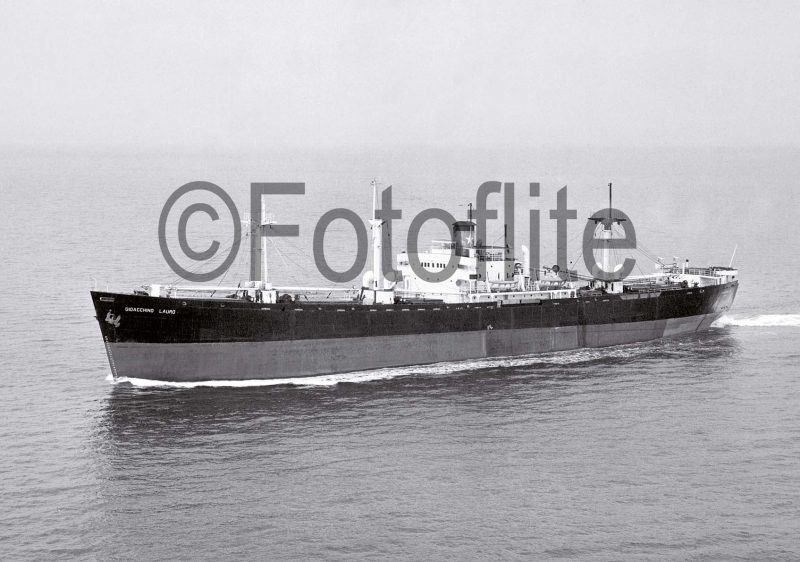
The first tramp ship was purchased in 1922 in the American steamer Lloyd of 3,872 grt, and had been built in 1895 for Norddeutscher Lloyd as Halle by the Germania Werft yard at Kiel. She was renamed Iris and had dimensions of length 356.9 feet by moulded beam of 43.7 feet with a depth of 25.5 feet and a long combined bridge and poop deck of 218 feet in length. The first voyages showed profits and longer voyages through the Suez Canal to East Africa, India and Indo China were made during the next five years. Achille Lauro succeeded in avoiding costly ballast voyages by loading his ships with coal from English ports to Italian ports and returning with grain from Romanian ports to Rotterdam. The profits were always reinvested in Flotta Lauro, with seven tramps owned in 1929 in Edera 3,851/02, Erica 4,376/04, Felce 5,938/10, Iris 4,787/07, Koefia 3,823/03, Liana 4,298/03 and Taide 2,770/21.
By 1932, his only Italian competitors were the fleets of Costa and Fassio, and he owned a fleet of a dozen tramps on worldwide tramping as well as on a service from Italian ports to Italian East Africa. Achille Lauro made substantial money from the arms trade linked to the colonial expansion of Italian Fascism, which culminated in the conquest of Ethiopia in 1933. Flotta Lauro and the Lauro businesses blossomed with the help of influential members of the Fascist National Party, which Achille Lauro also formally joined in 1933. He had the support for many years in the 1920s and 1930s of the Ciano shipowning family, and became national counsellor to the Camera dei Fasci e delle Corporazioni. Galeazzo Ciano was none other than the son-in-law of Italian dictator Benito Mussolini. Achille Lauro was a very popular figure in inter-war Naples, and was President of the Naples football club SSC Napoli. He was appointed as a Knight of the Order of Merit of the Italian Government in 1938 for the good labour relations in his businesses. He obtained in 1936 the monopoly passenger and freight concession for the service from Italy to East Africa.
Flotta Lauro had become the largest private shipping fleet in Italy with a large fleet of 57 ships, including three tankers, at the outbreak of war in September 1939, the vast majority having been purchased during the 1930s decade. By comparison, the Italia Line fleet of liners and cargo ships that began operations on 2nd January 1937 had only 39 ships. Tramps had been purchased from the British fleets of Raeburn and Verel, Gow and Harrison, and Thomas Law of Glasgow, Frederick Bolton of London, Dalgleish, Common Brothers and Souter of Newcastle, Court Line, James Chambers of Liverpool, Hain of Cornwall, the Anglo-Celtic Shipping Company of London, as well as the German fleets of Rickmers and Hansa Line, and the Italian shipping company of Sicula Americana founded in Naples in 1919. Standard Canadian built tramps dating from the period just after the end of World War I were purchased from Canadian National Steamships Ltd. and renamed after his father Gioacchino Lauro (ex Canadian Commander) and after himself Achille Lauro (ex Canadian Explorer), with others renamed as Procida (ex Canadian Traveller) and Rapido (ex Canadian Pioneer).
The trio of tankers in the fleet in 1939 were Portofino of 9,250 dwt and completed during World War I as Roseleaf becoming British Rose of the Anglo-Iranian Shipping Co. Ltd. (BP), and the sisters Fede and Lavoro of 12,293 dwt built in 1938 by the Cantieri Riuniti dell’ Adriatico yard at Trieste for long term charter to ENI of Italy. The largest dry cargo ship in the fleet was the cargo-liner Cuma of 10,800 dwt, built in 1920 by Workman, Clark of Belfast as the standard turbine powered ‘N’ class Nictheroy for Royal Mail Line and purchased by Lauro in 1937. All of the Lauro fleet had black or grey hulls with red boot topping and white masts, with funnel colours of blue with a black top and a white five pointed star, the swallow tailed houseflag being blue with the same white five pointed star. Achille Lauro joined the National Federation of Shipowners, mostly composed of Northern Italian competitors.
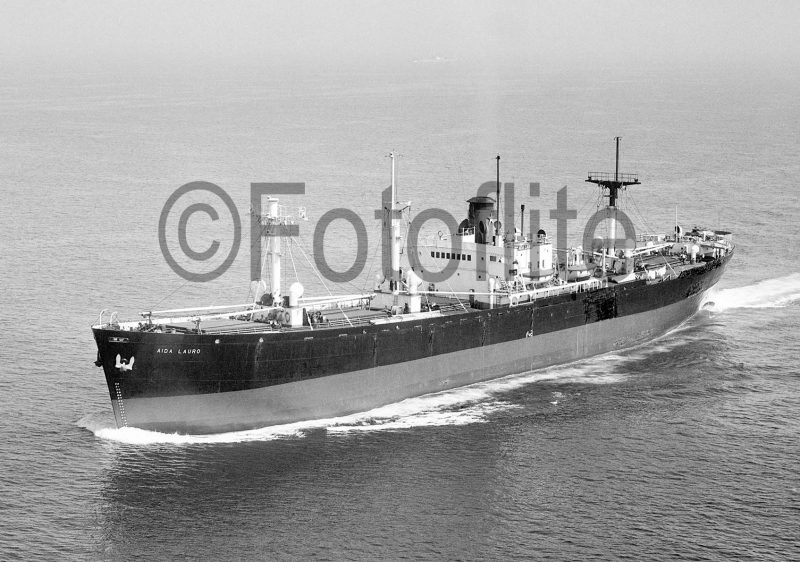
Flotta Lauro World War II Losses
The big fleet of 57 dry cargo, tanker and coastal vessels of over 300,000 grt that was requisitioned by the Italian Government of Benito Mussolini the day after Italy entered the war on 10th June 1940 was completely devastated during the war, with only five survivors left afloat at the end of the war. The detailed breakdown of this staggering destruction was as follows:-
Deep Sea Dry Cargo Ships
Twenty nine of thirty vessels were lost from the pre-war fleet of Achille Lauro, Aida Lauro, Amelia Lauro, Angelina Lauro, Antonietta Lauro, Antonio Limoncelli, Cuma, Edera, Elios, Ercole, Erica, Felce, Gabbiano, Gioacchino Lauro, Guidonia, Iris, Ischia, Laura Lauro, Liana, Lucrino, Nita, Olimpia, Pozzuoli, Procida, Rapido, Sagitta, Santagata, Tina Primo, Veloce and Verbania. Edera was the only survivor to be returned to Lauro in 1945 after being taken over by the Allies on 24th December 1943.
Deep Sea Tankers
All three lost from the pre-war fleet of Fede, Lavoro and Portofino.
Coastal Vessels
Twenty vessels lost from the pre-war fleet of Alessandro Podesta, Alga, Aprilla, Aurora, Brundusium, Enotria, Giglio, Loreto, Marzameni, Nerucci, Pallade, Paolo Z. Podesta, Penelope, Peuceta, Pier Luigi, Polinice, Polinnia, the motor vessel Pomona, Sandrina, Serdica, Siculo and Sportivo.
In 1939, Achille Lauro had become the first President of the Armed Forces of Southern Italy and the islands, and was arrested by the victorious Allies after the Italian surrender and the liberation of Naples in November 1943 and interned in a prison camp for twenty two months. He was then put on trial charged with collaboration and aiding and abetting with the Italian Fascists and having illegally enriched himself from wartime businesses. He was eventually acquitted of all charges by the Court of Appeal in Naples and was freed in 1946 to rebuild his shattered fleet once again.
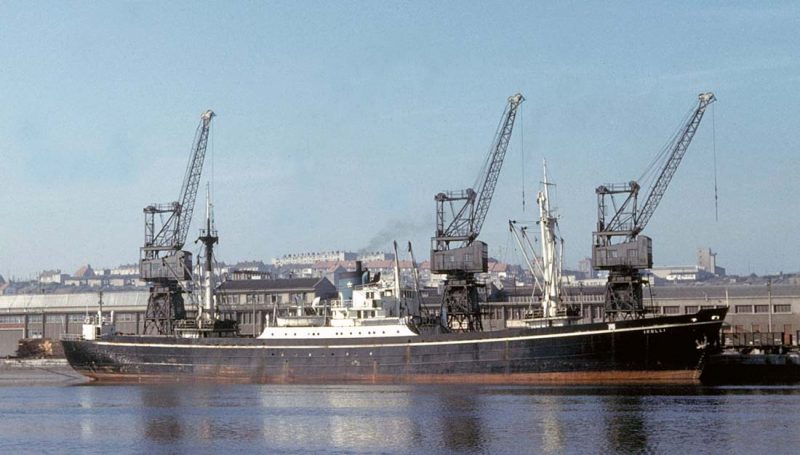
Post-War Rebuilding
Achille Lauro had acquired in 1942 with the support of Benito Mussolini a half share in the Societa Editrice Napoletana, publisher and owner of three Neapolitan newspapers, Il Mattino, Il Courier and Roma, which had previously been State owned through the Bank of Naples. Achille later became the full owner and editor of the newspaper Roma. He also needed a cheap supply of standard war built American tonnage and this was achieved by the purchase of six ‘Liberty’ types renamed Aida Lauro, Angelina Lauro, Gioacchino Lauro, Iris, Laura Lauro and Olimpia, and two ‘T2’ tanker types renamed Achille Lauro and Amalfi. He also entered the highly profitable business of transporting tens of thousands of Italian migrants, who could see no future in post-war Italy, to Australia and South America. The converted liners Ravello, Napoli, Roma, Sydney, the twin funnelled Surriento, and the former Dutch pair of Achille Lauro and Angelina Lauro were to bring big profits into the Lauro family.
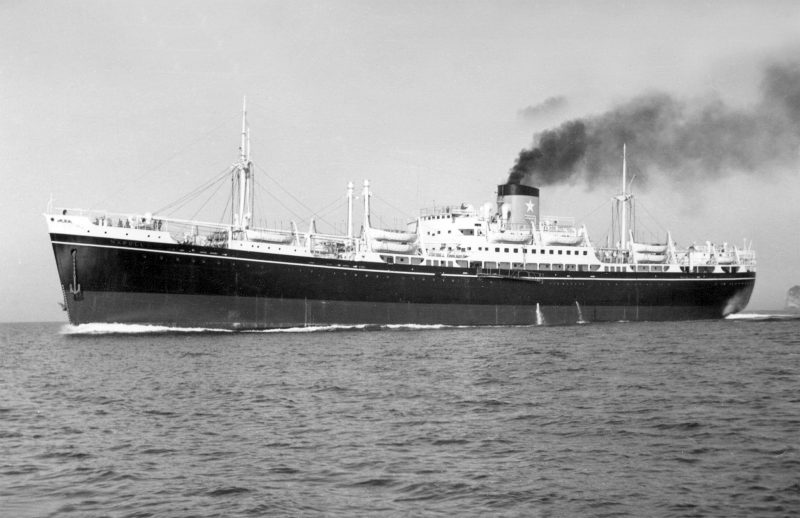
Ravello was a cargo ship completed in 1941 and rebuilt in 1949 as a migrant carrier, and made three voyages from Genoa to the Australian ports of Fremantle, Melbourne and Sydney with migrants during 1950/51. She was then transferred to the South American trade after the arrival in service of two other converted liners, Roma and Sydney, rebuilt from World War II escort carriers during 1948/51 with accommodation for 758 migrants on the route between Italy and Australia. Roma was broken up in 1967, with Sydney then renamed Roma and used for Mediterranean cruising until sold a year later and was broken up in 1975. Surriento was the former Santa Maria of 7,858 grt of Grace Line completed in 1928 by the Haverton Hill shipyard of Furness, Withy & Co. Ltd. and purchased in 1949 for conversion to a migrant ship with accommodation for 187 First Class passengers and 868 migrants. She retained her twin funnels until she was reduced to only one funnel in a 1959 refit, and she was broken up in 1966.
Napoli was rebuilt from the shattered hull of the Bank Line cargo ship Araybank, which was sunk off Crete in 1941 and salvaged in 1947 and put into service by Lauro a year later carrying 650 migrants between Genoa, Naples, Messina and the Australian ports of Fremantle, Melbourne and Brisbane and calling at Singapore and Colombo homewards. She was transferred to the Lauro Caribbean and Central American service in 1951, and arrived for breaking up at La Spezia on 3rd April 1971. Later, Lauro Line employed two former Dutch liners, Oranje and Willem Ruys, as Angelina Lauro and Achille Lauro between 1966 and 1972/73 in the Australian emigrant service.
The Lauro fleet in 1950 consisted of thirty vessels comprising six purchased ‘Liberty’ types, two purchased ‘T2’ tanker types, the motorship Fede 7,417/43 from the Ansaldo yard at Genoa Sestri, the salvaged tanker Lavoro dating from 1938 and completed by the Cantieri Navale dell’ Adriatico yard at Trieste, the old tramp Lucrino 5,591/17 completed at Sunderland and now rebuilt with a diesel engine, the emigrant liners Napoli ex Araybank, Ravello, Surriento and Roma, and over a dozen small coasters including a new quartet built by the Cantieri Navale Franco Tosi yard at Taranto of 2,500 dwt and powered by six cylinder two stroke diesel engines manufactured by the shipbuilder. This quartet was named Gemito, Irolli, Morelli and Palizzi.
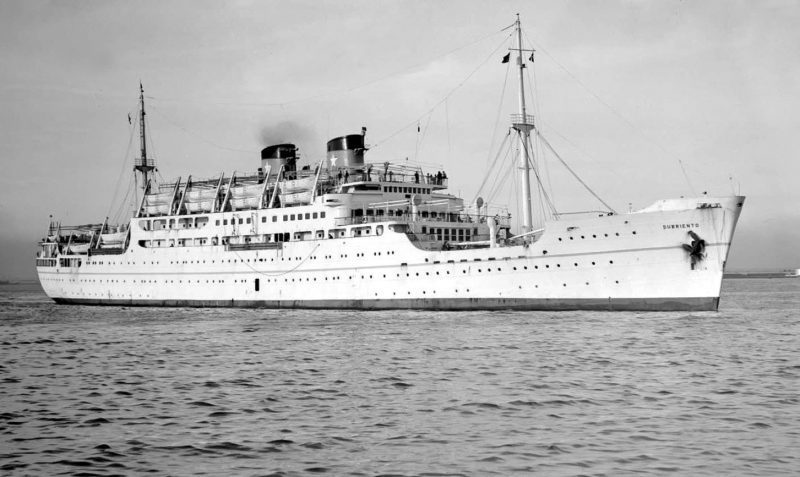

In post war years, Achille Lauro obtained long term freight contracts with Fiat of Turin for car shipments to the U.S.A., and with oil company ENI for long term lease of his ore/oil carriers and tankers. New ships were commissioned in State owned yards, and by 1952 he was a multi millionaire and owner of a large fleet of thirty ships, and by then had been freed from the cloud of Fascist collaboration, and he re-entered politics in that year, helping to fund the new Monarchist Party, and serving as a very popular Mayor of Naples between 1952 and 1957 and again between 1960 and 1961. He received more votes in the municipal Napoli elections than any other previous candidate, polling almost 300,000 votes. He was elected as a member of the Italian Chamber of Deputies and served continuously between 1958 and 1979, again achieving very high numbers of votes for this Italian Government post. He edited the daily Roma newspaper and retained his term as President of football club SSC Napoli. He became known through his shipping, newspaper, football club and political activities as the ‘King of Naples’.
During the 1960s, his shipping business prospered, but after being outvoted in 1961 on the Naples City Council, he never regained absolute political power in Naples. He owned a large fleet of forty ships of 650,000 dwt during this decade on a turnover of more than 200 billion Italian lire and Head Offices in Naples and Genoa. He took back the reins of his shipping business from his son Ercole, the third born child of his marriage with his wife Angelina, who he felt was mismanaging it. The fleet consisted of the emigrant liners Napoli, Ravello, Roma, Surriento and Sydney, as well as a trio of modern tankers of 26,260 dwt built in 1952/53 by the Ansaldo yard at Genoa as Coraggio, Tenacia and Volere, eight wartime built dry cargo ships, two ‘T2’ type tankers and the salvaged tanker Lavoro, ten coasters, as well as the oldest vessel in the fleet in the motorship Giulia of 8,250 dwt built back in 1925 by the Monfalcone yard of Cantieri Navale Triestino and rebuilt after the war in Genoa.
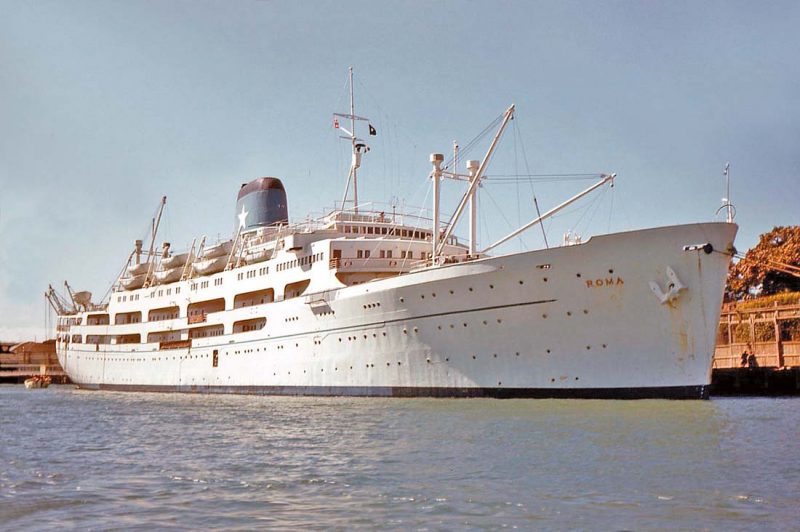
Flotta Lauro Palermo Subsidiaries
Achille Lauro set up a subsidiary shipping company in Palermo in 1958 as the Nereide spA di Navigazione to own two engines aft bridge ‘midships tankers of 31,195 dwt, Felce and Polinice, built during that year. They were given black hulls with blue funnels and a black top next to a thin white band with a central blue ‘N’ for Nereide on a white disc. Achille Lauro also set up at least nine other shipping subsidiaries in Palermo, in Elios spA di Navigazione, Aretusa spA di Navigazione, Pluto spA di Navigazione, Egeria spA di Navigazione, Alcione spA di Navigazione, Megara spA di Navigazione, Pollinia spA di Navigazione, Erice spA di Navigazione and Eraclide spA di Navigazione.
Ships known to have been registered under these ten companies included the ULCC tanker Coraggio, the VLCC tanker Volere, ore/oil carrier Ercole of 64,325 dwt and sister Egeria completed in 1960/61 by the Ansaldo Sestri yard at Genoa, and the sister ore/oil carriers Laura Prima and Lily Prima of 139,400 dwt built in 1971 at the Monfalcone yard, and sister ore/oil carriers Aretusa, Brasilia, Elios, Eraclide and Igara of 136,200 dwt built in 1972/73. The tankers and ore/oil carriers of all of these Palermo subsidiaries were chartered to ship Nigerian crude oil to Genoa, including the tanker Raffaele Cafiero of 38,594 dwt and built in 1962.
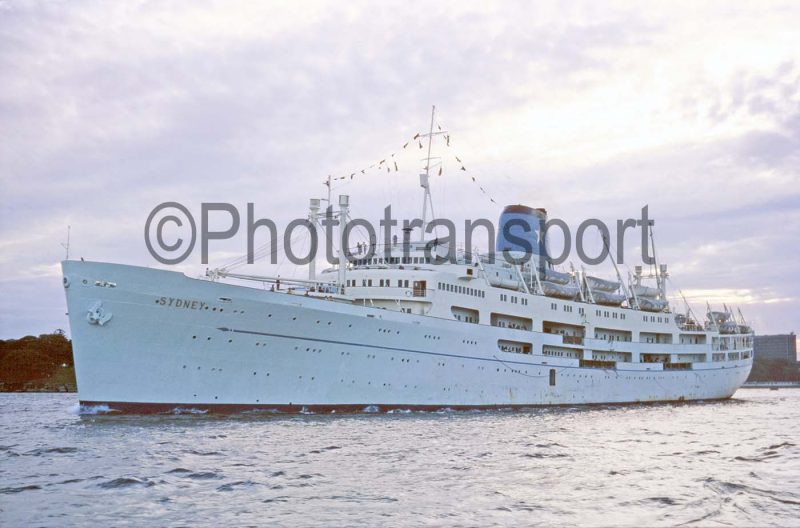
Dry cargo bulkers registered under these companies included Edera of 45,700 dwt built in 1962, Amalfi of 61,000 dwt built in 1963, Simonetta of 28,712 dwt built in 1963, sisters Donatella, Massimo Primo, Manuela Prima and Pollinia of 26,950 dwt built during 1962/65, and sisters Santagata and Sorrento of 67,900 dwt built in 1967 at the Monfalcone yard, and Pallade of 19,500 dwt built in 1959. Cargo-liners registered under these companies included Rapido of 15,793 dwt built in 1957, and the sister cargo-liners Capriolo, Gazzella and Tigre of 13,200 dwt built in 1969/70, as well as Cervo of 12,896 dwt, Megara of 13,615 dwt and Palizzi of 12,666 dwt, and sisters Penelope (ex Devon) and Rapido (ex Argyll) of 12,548 dwt and built in 1957/58. Lauro Transoceanica Liner Services spA di Navigazione was also registered in Palermo.
A close working relationship was also built up with Dr. Sebastiano Tuillier (1910-1982) of Lugano in Switzerland, with the latter managing six ships for Lauro between 1965 and 1973. A trio of tankers built by IHI at Yokohama in Japan in 1965 were managed by the Benedict Shipping Corporation of Lugano in Benedict and Capoverde of 71,140 dwt and Cape Horn of 87,000 dwt. Two of the Nereide company tankers, Felce and Polinice, were renamed Acquarius and Mabruk in 1968 and given to Tuillier for management in 1972. The Newcastle owned general cargo ship Hopecrest of 15,000 dwt, owned firstly by the Hopemount Shipping Co. Ltd. when completed in 1961 and then by Common Brothers from 1966, was purchased by Lauro in 1969 and renamed Selene and also given to Tuillier for management until 1973, and was then sold off to Greek owners in 1976 and renamed Faneromeni.
Emigrant Liner Finale
Roma and Sydney were two popular emigrant liners that had undergone massive rebuilding from World War II escort carriers during 1948/51. They had accommodation for 92 First Class passengers and 666 passengers in Tourist Class. The First Class passengers were accommodated on ‘A’ Deck, ‘B’ Deck and ‘C’ Deck, with their forward facing wraparound Main Lounge at the forward end of ‘A’ Deck, and verandah promenades at the sides of the First Class accommodation before reaching the aft swimming pool and lido. The First Class public rooms included the Dining Room, Main Lounge, Verandah Bar, Club Bar, and Card Room. The centreline of ‘B’ Deck had the base of a two deck atrium, one of the first ever built into a liner in the late 1940s, with Tourist Class public rooms including the Dining Room, Main Lounge, Verandah Bar, and Reading and Writing Room. Tourist Class cabins were aft on ‘B’ Deck and ‘C’ Deck, with First Class cabins forward, and the remainder of the Tourist Class cabins filled all of the lower decks.
Roma and Sydney were taken out of service during 1966/68, having been replaced by two popular but accident prone Dutch liners. They collided head on in the Red Sea in 1953 when approaching too close to each other while waving to their fellow passengers and officers. They were purchased by Lauro in 1964 and rebuilt in Italian yards before they were ready for service in 1966 and named after Achille and his wife Angelina. Oranje built in 1939 by the Nederland Dock yard at Amsterdam was rebuilt by the Cantieri Navale Riuniti yard at Genoa with accommodation for 180 First Class, 377 Interchangeable Class, and 948 passengers in Tourist Class and renamed Angelina Lauro. The twin funnelled Willem Ruys was completed in 1947 by the De Schelde yard at Flushing and rebuilt by the Cantieri Navale Riuniti yard at Palermo as Achille Lauro with accommodation for 270 First Class, 394 Interchangeable Class, and 917 Tourist Class passengers.
Achille Lauro and Angelina Lauro served on the Australian migrant service between 1966 and 1972/73 and then went cruising for Lauro Line. Angelina Lauro was lost by fire at the island of St. Thomas in the West Indies on 31st March 1979. Achille Lauro helped evacuate the families of British servicemen during the Six Day War of 1967 in the Middle East, and after conversion to a cruise ship in 1972, she suffered a collision in 1975 and a severe fire in 1981 but sailed on for many years after the bankruptcy of Lauro Line in 1982. She suffered a hijacking by four Palestinian terrorists on 7th October 1985, but became a member of the StarLauro and MSC cruising fleet until she was destroyed by fire and sank off the East African coast on 2nd December 1994. The fire started three days earlier while she was en route to South Africa in her engine room after one of her engines exploded and burned out of control for several hours, with her crew fire fighting efforts ultimately unsuccessful, she was abandoned and sank.
The dry cargo fleet of Flotta Lauro was not neglected with the purchase in 1966 of the former five hold engines ‘midships Continental Trader of 10,550 dwt, built in 1958 and owned and then renamed Woodburn by Common Brothers of Newcastle, and renamed Pegaso by Lauro. Four engines aft six hold turbine propelled Japanese built dry cargo ships dating from 1956/58 were then purchased as the sisters Andros Gale and Andros Glamour of 15,600 dwt built by IHI and renamed Fede and Pomona respectively, and Liana of 15,113 dwt built as National Progress in 1956 by the Uraga Dockyard, and Valparaiso of 15,544 dwt, purchased in 1966 and traded for nine years, having been built in 1958 by the Mitsubishi yard at Hiroshima as Dorset. They had dimensions of length 525.0 feet by moulded beam of 62.6 feet with a loaded draft of 30.7 feet as closed shelterdeckers.
Giaocchino Lauro was a fast twin funnelled cargo-liner with a service speed of eighteen knots and accommodation for a dozen passengers when completed in 1972 by the Sestao yard of Astilleros Espanoles and capable of carrying 16,000 tonnes of cargo. She had derricks on three sets of goalpost masts plus a centreline mast forward, and hull dimensions of length 154.6 metres by moulded beam of 23.3 metres, and had three Lauro owned sisters in Gherenuk, Kudu and Turmalin, the latter ship later becoming Aniello of Mediterranean Shipping Company. This class gave over thirty years of sterling service to Italian owners.
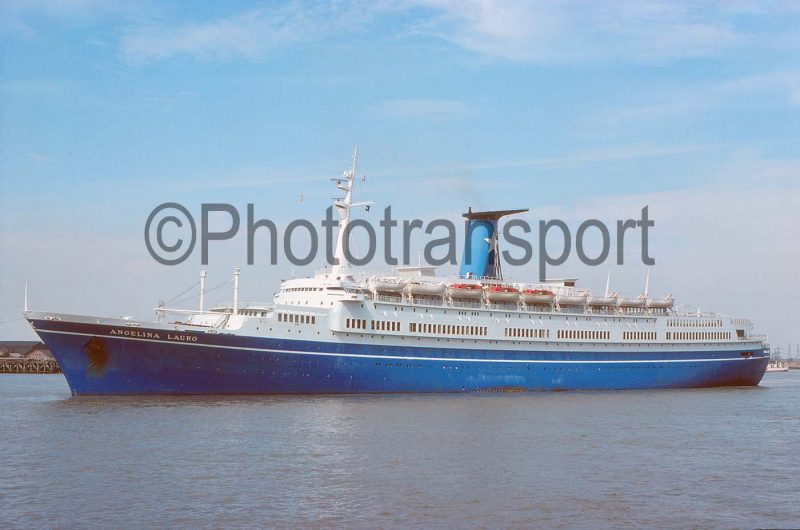
The Final Flotta Lauro Years
The Lauro shipping empire suffered badly from the huge price hike in fuel oil by the OPEC oil producing companies in 1973 while being managed by Ercole Lauro. Angelina Lauro, the wife of fifty years of Achille Lauro, died in 1973, and Achille then married the 35 year old actress Eliana Merolla, and tried to restructure his shipping and Neapolitan newspaper businesses. In the late 1970s, financial difficulties were experienced with the purchase of two giant oil tankers, Volere of 250,874 dwt and Coraggio of 423,798 dwt, and financial exposure to his dollar denominated ship mortgages led to a sudden liquidity crisis in the currency markets. Ships were seized and laid up at the request of creditors until bankruptcy was announced in December 1981 and the appointment of a commissioner for the liquidation of the Lauro Group.
In 1982, Flotta Lauro was renamed Lauro Line, and only the liner Achille Lauro and cargo ships Capriolo, Cervo, Gazzella, Gioacchino Lauro, Fede, Liana, Pegaso, Pomona and Tigre, as well as the new container ship Ercole Lauro of 25,868 dwt completed in 1980 by the Sestri Ponente yard at Genoa, remained of Flotta Lauro. The cargo fleet was engaged on voyages to Central America, to Chile and the west coast of South America, and to the Middle East. The Italian Minister for Industry gave the go-ahead for the sale of what remained of Flotta Lauro shortly before the death of the founder Achille Lauro on 15th November 1982 in Naples aged 95 years. Lauro Line had debts of over two hundred billion Italian lire.
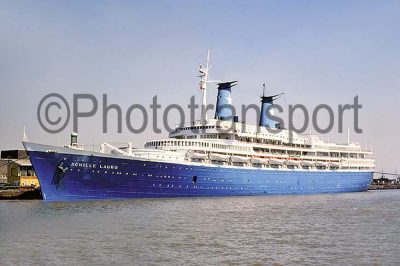
It was a sad fact that the founder had lost three fleets during the course of his long life, the first being a small sailing ship fleet inherited from his father and requisitioned and lost in World War I, the second being a very large fleet of tramps and tankers lost in World War II, and the third being a fleet of ships taken into receivership in late 1981 shortly before his death. The fleet continued to operate in administration with the number of employees reduced to only two thousand until it passed into the hands of two businessmen, Eugenio Buontempo and Salvatore Pianura, purchased at a public auction on 19th January 1987 for one hundred million lire. The company was renamed StarLauro, which controlled the VLCC tanker Volere built in Italy in 1972, and five dry cargo part container ships named Cervo, Tigre, Gazzella, Palizzi and Gioacchino Lauro as well as the cruise ship Achille Lauro. The company also acted as agents for other large tankers, ore/oil carriers and bulkers of other shipowners.
Gianluigi Aponte purchased the shares of Salvatore Pianura in December 1990 and those of Eugenio Buontempo in June 1991, and thus became the sole owner of StarLauro, and transformed it in 1995 into his new MSC container and cruise business. Gianluigi Aponte had, like many other Neapolitans, grown up in Naples with Achille Lauro as a hero figure, and placed the cruise ships Monterey (ex Free State Mariner), Symphony (ex Provence), Rhapsody (ex Cunard Princess) and Melody (ex Atlantic) under his MSC Cruises. The Mediterranean Shipping Company (MSC) container and cruise ship fleets are among the biggest in the world today, with many new big ships entering service every year.
Flotta Lauro Head Offices
Reminders of the glory days of Flotta Lauro are present today in the two former Lauro Head Office buildings in Naples and Genoa. The Naples office was on the harbour road of Via Marittima, and was an impressive building called Via Nuova Marittima Palazzo Lauro and was designed by architect Antonio Scivittario and completed in 1950 as one of the main buildings of the ‘Cosenza Plan’ drawn up in 1946 for the reconstruction of the heavily bomb damaged city. It had a fully glazed ‘wall’ facing the harbour, and the body of the building was divided into two parts. The basement was built on two levels, and the seven floor main part of the office had white marble slabs on its other sections to continue the look of the glass surface of the side facing the harbour. The design of this ‘glass palace’ was a typical post-war Neapolitan building with its own individualistic look, and owed nothing to the design of skyscrapers by Le Corbusier and others.
The Genoa office of Palazzo Lauro looked out over the busy Piazza della Nunziata in Genoa near the harbour, and can be visited by the general public as they enter the very impressive portico with ‘Flotta Lauro’ in large emblazoned letters above the portico. The building dates back to the end of the 16th century as the home of the father of the Grand Doge of Genoa. The impressive entrance hall and winding staircase of this meticulously preserved building was reconstructed in 1949 by Achille Lauro after severe damage by Allied bombing in 1943. This Lauro office underwent a prestige restoration led by architect Robaldo Morozzo della Rocca, who kept the original facade, but built a new atrium whose ceiling is embellished with a fresco of angels in the style of the Genoese painter Andrea Carlone. At the top floor of the atrium are walls decorated with features representing the four rival maritime republics of Italy in Genoa, Venice, Pisa and Amalfi. Achille Lauro is said to be represented as Neptune on one of these panels. This beautiful building is today used as five floors of offices, with the maritime link continued as one of the floors is occupied by MOL Europe, the European subsidiary of Japanese shipping company Mitsui.
Postscript
The Achille Lauro fleet was the largest Italian fleet from the 1930s decade to the 1970s decade, and larger than the State owned Italia Line fleet. The latter had 39 ships when formed in early 1937, 22 ships in 1952 and the same number of ships in 1960, but only seventeen ships in 1973 when it was one of the four constituent parts of the State owned Finanziaria Marittima along with the Adriatica, Tirrenia and Lloyd Triestino fleets.
The private giant ‘Flotta Lauro’ of Naples, built up by one man Achille Lauro, has been repeated only once by a Neapolitan shipowner, this person being Gianluigi Apointe of Naples, with his giant fleet of MSC container and cruise ships today. A square in the coastal town of Sorrento near his birthplace has been named in honour of Achille Lauro, the great Naples shipowner.

The white hulled emigrant liners of Napoli, Ravello, Surriento, Roma and Sydney, and the later blue hulled former Dutch pair of Achille Lauro and Angelina Lauro, are the liners that are remembered by those that travelled to new lives on distant continents and by ship enthusiasts, but the cargo ship, ore/oil, bulker, container ship and tanker fleet was also very interesting and has never really been documented before. Achille Lauro was a very astute Neapolitan shipowner, who commanded the adulation of the Napoli public, but as with most great men he had a darker side to his nature in the build up to war in pre-war Fascism in Italy. Achille Lauro lived life to the full during his 95 years, with his fleets of ships becoming very well known throughout the world.
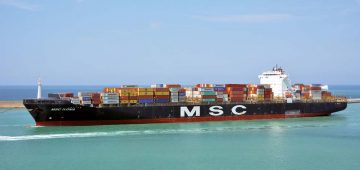



Comments
Sorry, comments are closed for this item